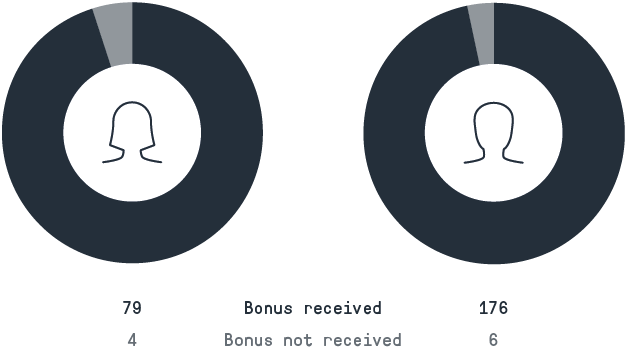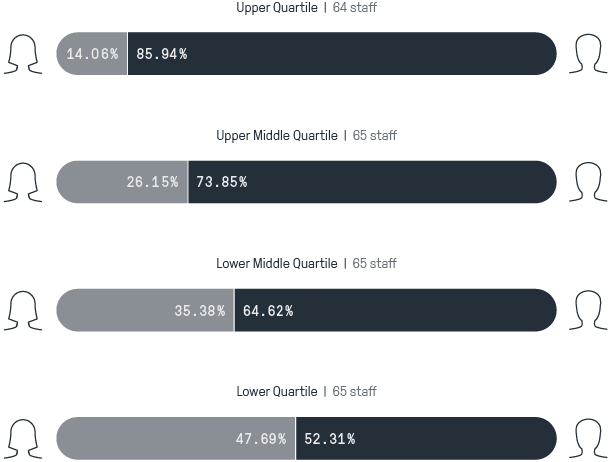2022
UK Gender Pay Gap
Introduction to the UK Gender Pay Gap
The gender pay gap refers to the difference between the hourly pay of men and women, including base pay, allowances, bonuses and incentives.
The gender pay gap reporting regulations were brought in by the UK government in 2017 to address the difference in pay for women and men. The regulations require employers with 250 or more employees to publish their gender pay gap data on April 5 each year (known as the ‘snapshot date’), based on the following measures:
- Gender pay gap – mean and median
- Bonus gap – mean and median
- Bonus proportions
- Quartile pay bands
It’s important to note that gender pay is not a measure of equal pay, which relates to men and women receiving equal pay for equivalent work. The gender pay gap aggregates data on the hourly pay of men and women regardless of role.
The gender pay gap at CDP
As of April 5, 2022, we passed the threshold of 250 employees set by the UK government for gender pay gap reporting. As this is the first year of reporting, we don’t yet have data from previous years available for comparison.
Our gender pay gap is primarily the result of having a larger overall proportion of men compared to women in senior technical and leadership positions. This is not uncommon in a Science, Technology, Engineering and Mathematics (STEM) company like ours, and whilst we’ve already taken steps to close the gap, we recognise that more needs to be done – both generally and specifically here at CDP – to attract, recruit, develop, promote, and retain women in STEM careers.
For context, Office for National Statistics (ONS) data show that the median gender pay gap among all employees in the UK in 2022 was 14.9%, down from 15.1% in 2021. In its summary, the ONS notes that “over the coronavirus (COVID-19) pandemic period, earnings estimates were affected by changes in composition of the workforce and the impact of the Coronavirus Job Retention Scheme (furlough) making interpretation difficult; also data collection disruption and lower response rates mean that, for 2020 and 2021, data were subject to more uncertainty and should be treated with caution.”
Gender pay gap
This shows the difference between the hourly rate of pay of male full-pay relevant employees and that of female full-pay relevant employees

Bonus gap
This shows the difference between the bonus pay paid to male full-pay relevant employees and that paid to female full-pay relevant employees

Bonus proportions
This shows the proportions of male and female relevant employees who were paid bonus pay

Quartile pay bands
This shows the proportions of male and female full-pay relevant employees in the lower, lower middle, upper middle and upper quartile pay bands

What we’re doing about it
“Change will not come if we wait for some other person or some other time. We are the ones we’ve been waiting for. We are the ones that we seek.”
We’re committed to ensuring fair and equal pay throughout our company, and continuing to review and improve our policies and practices to reduce our gender pay gap. Here are some of the specific things we’re doing to achieve that.
Diversity, Equity & Inclusion
In 2022, we established our Diversity, Equity & Inclusion (DE&I) committee, and which over the past 12 months, has focussed on six key areas:
- Formalising the group
- Celebrating with pride
- Finding our way
- Educating ourselves
- Listening to employee-owners
- Influencing policy
And, in March 2023, we launched our Women in Leadership programme. We’re partnering with Sonya Barlow (inclusion expert, careers coach and author) to support us in further shaping and delivering on our DE&I commitments.
Early Careers and STEM outreach
A key factor in addressing the gender pay gap is attracting, recruiting, developing, promoting, and retaining women in STEM (Science, Technology, Engineering and Mathematics) careers. We’re focused on creating and fostering an inclusive workplace culture within CDP, where we challenge and educate ourselves about unconscious biases and stereotypes.
As a STEM employer, we recognise the shortage of skilled workers and want to help build the available pipeline of talent through early careers and outreach activities, to encourage and inspire young people – particularly underrepresented women – to consider a career in STEM.
We encourage and support employee-owners to invest in STEM outreach and volunteering activities with paid time off, in addition to working in partnership with Form the Future and Cambridge Launchpad.
Career, development & performance
We’re proud of our meritocratic approach, but we also acknowledge that more needs to be done to better support our employee-owners’ career goals and development. Having carried out a cross-functional review in 2022 (which spanned the entire company, across all levels of seniority, lengths of service, genders, and locations), a new approach to our Career, Development & Performance framework has been recommended and will be launched shortly.
People policies and processes
We’re committed to reviewing our People policies and processes, including recruitment, to ensure inclusive practices. We already ensure that all vacancies are advertised internally, all adverts use gender neutral and inclusive language, and all requests for part-time working are seriously considered.
Agile/Flexible Working
We continue to adopt and promote flexible working practices, to help all employee-owners balance their professional and personal commitments. Find out more about flexible working at CDP.